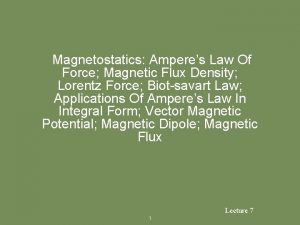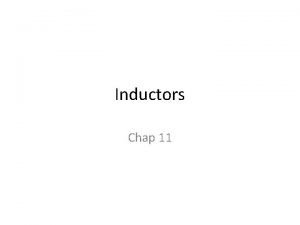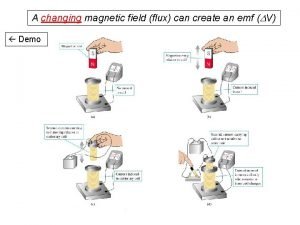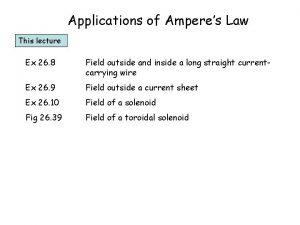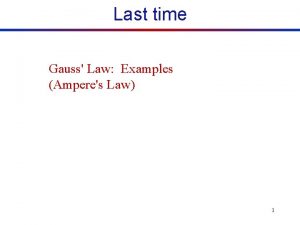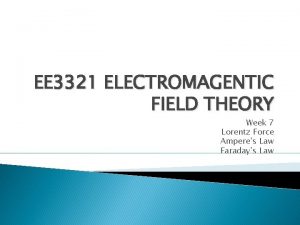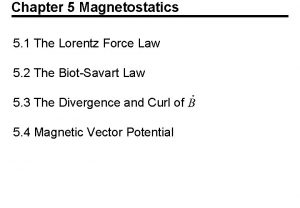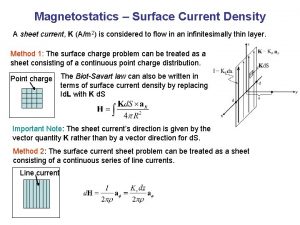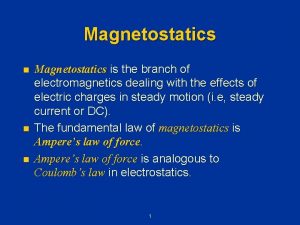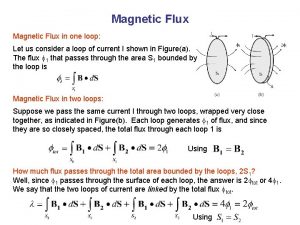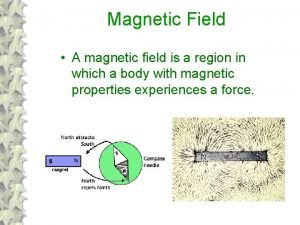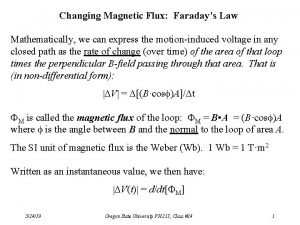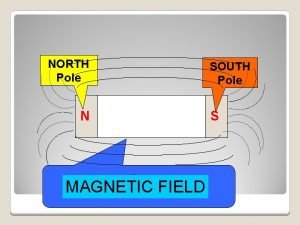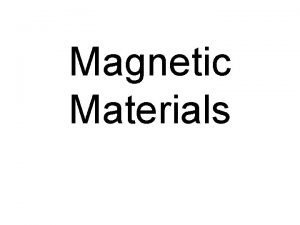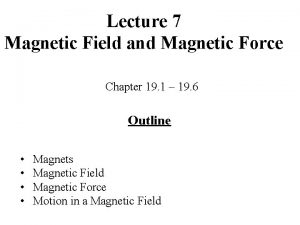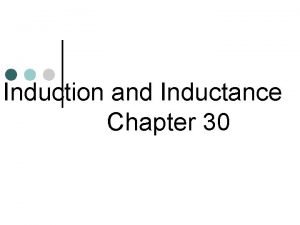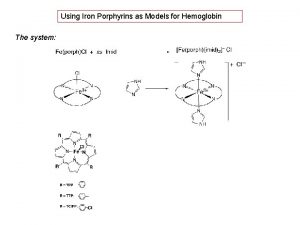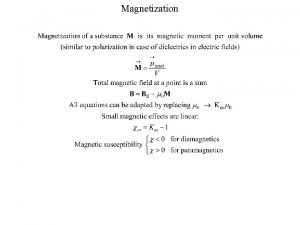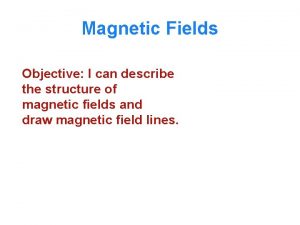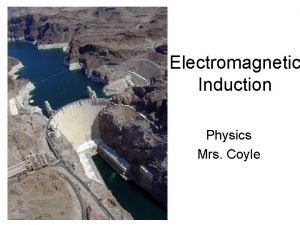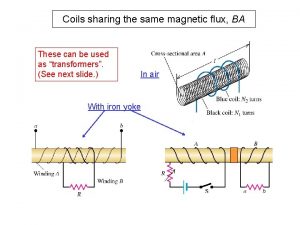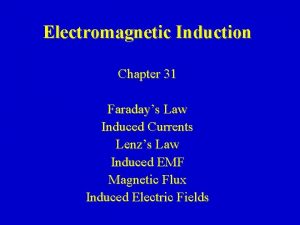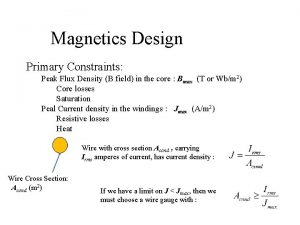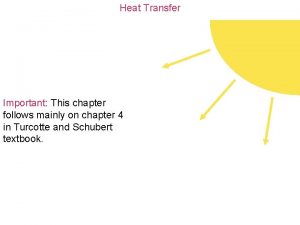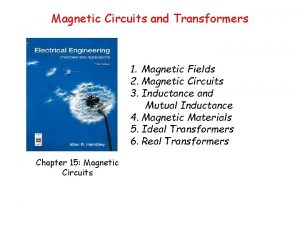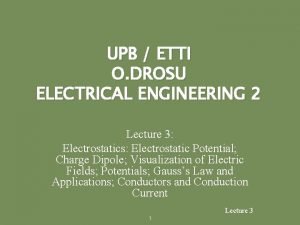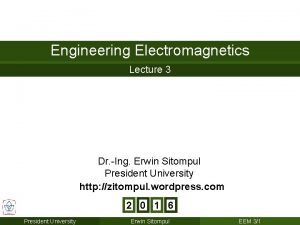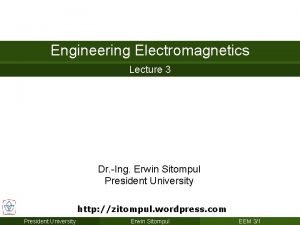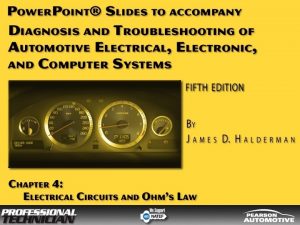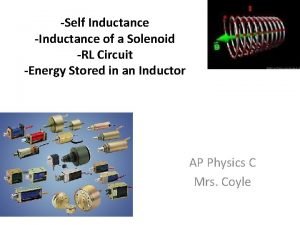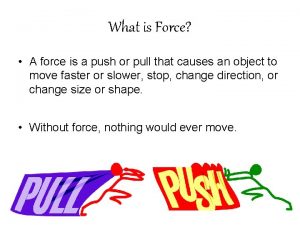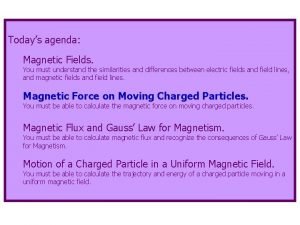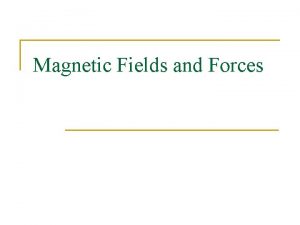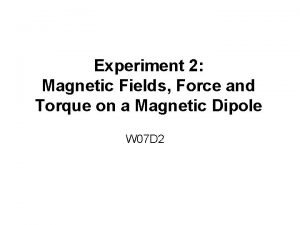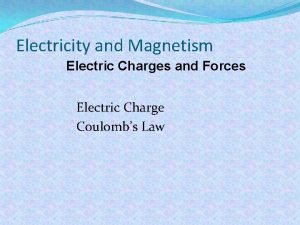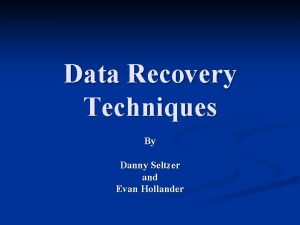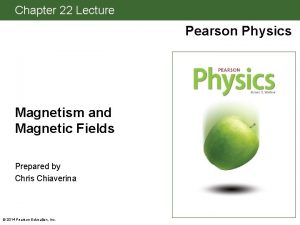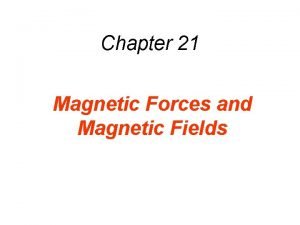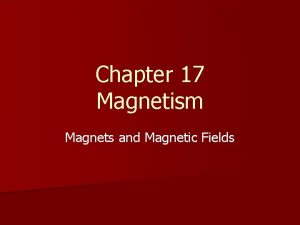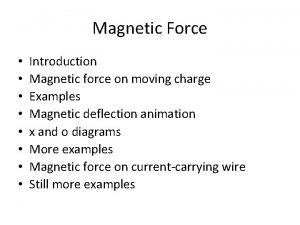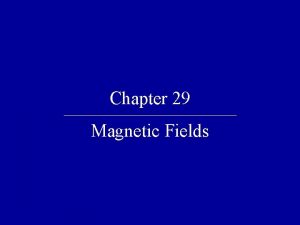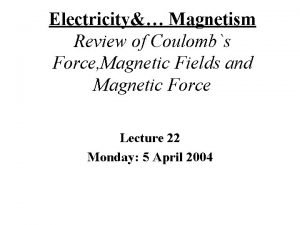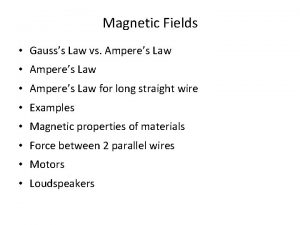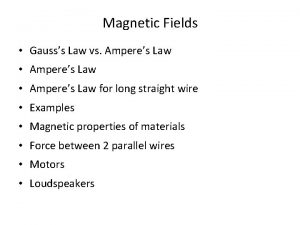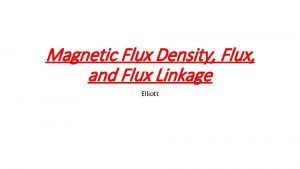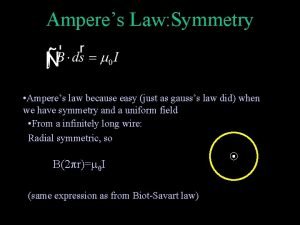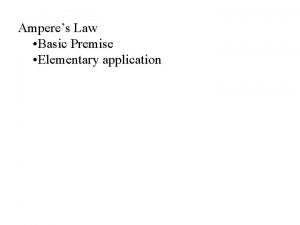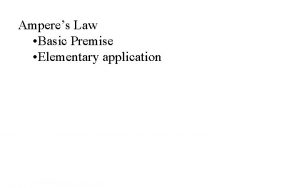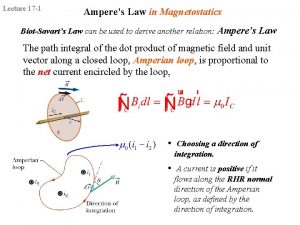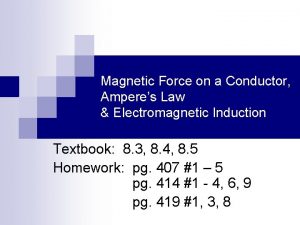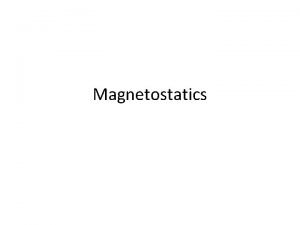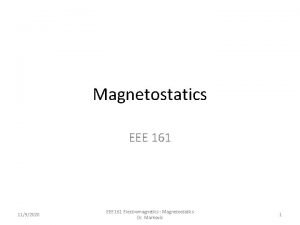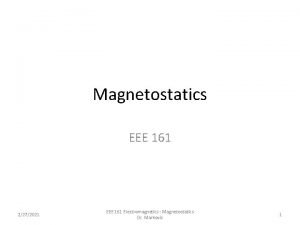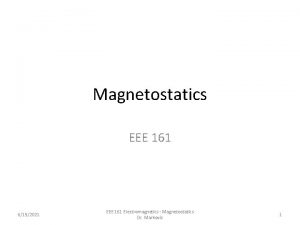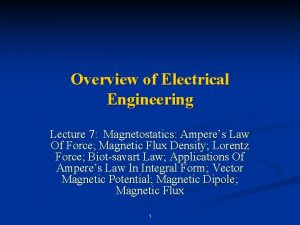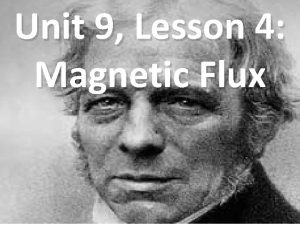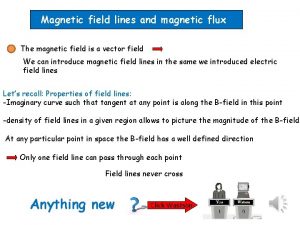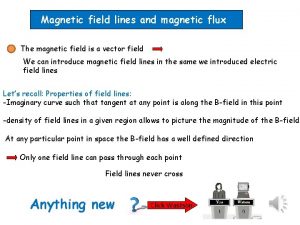Magnetostatics Amperes Law Of Force Magnetic Flux Density






























































- Slides: 62

Magnetostatics: Ampere’s Law Of Force; Magnetic Flux Density; Lorentz Force; Biot-savart Law; Applications Of Ampere’s Law In Integral Form; Vector Magnetic Potential; Magnetic Dipole; Magnetic Flux Lecture 7 1

Objectives To begin our study of magnetostatics with Ampere’s law of force; magnetic flux density; Lorentz force; Biot-Savart law; applications of Ampere’s law in integral form; vector magnetic potential; magnetic dipole; magnetic flux. Lecture 7 2

Overview of Electromagnetics Fundamental laws of classical electromagnetics Special cases Electrostatics Maxwell’s equations Magnetostatics Electromagnetic waves Statics: Input from other disciplines Geometric Optics Transmission Line Theory Circuit Theory Kirchoff’s Laws Lecture 7 3

Magnetostatics Magnetostatics is the branch of electromagnetics dealing with the effects of electric charges in steady motion (i. e, steady current or DC). The fundamental law of magnetostatics is Ampere’s law of force is analogous to Coulomb’s law in electrostatics. Lecture 7 4

Magnetostatics In magnetostatics, the magnetic field is produced by steady currents. The magnetostatic field does not allow for inductive coupling between circuits coupling between electric and magnetic fields Lecture 7 5

Ampere’s Law of Force Ampere’s law of force is the “law of action” between current carrying circuits. Ampere’s law of force gives the magnetic force between two current carrying circuits in an otherwise empty universe. Ampere’s law of force involves complete circuits since current must flow in closed loops. Lecture 7 6

Ampere’s Law of Force Experimental facts: parallel wires carrying current in the same direction attract. Two parallel wires carrying current in the opposite directions repel. F 21 F 12 Two I 1 F 21 I 2 F 12 I 1 I 2 Lecture 7 7

Ampere’s Law of Force Experimental facts: A short currentcarrying wire oriented perpendicular to a long currentcarrying wire experiences no force. F 12 = 0 I 2 I 1 Lecture 7 8

Ampere’s Law of Force Experimental facts: The magnitude of the force is inversely proportional to the distance squared. The magnitude of the force is proportional to the product of the currents carried by the two wires. Lecture 7 9

Ampere’s Law of Force The direction of the force established by the experimental facts can be mathematically represented by unit vector in direction of current I 1 unit vector in direction of current I 2 unit vector in direction of force on I 2 due to I 1 unit vector in direction of I 2 from I 1 Lecture 7 10

Ampere’s Law of Force The force acting on a current element I 2 dl 2 by a current element I 1 dl 1 is given by Permeability of free space m 0 = 4 p 10 -7 F/m Lecture 7 11

Ampere’s Law of Force The total force acting on a circuit C 2 having a current I 2 by a circuit C 1 having current I 1 is given by Lecture 7 12

Ampere’s Law of Force The force on C 1 due to C 2 is equal in magnitude but opposite in direction to the force on C 2 due to C 1. Lecture 7 13

Magnetic Flux Density Ampere’s force law describes an “action at a distance” analogous to Coulomb’s law. In Coulomb’s law, it was useful to introduce the concept of an electric field to describe the interaction between the charges. In Ampere’s law, we can define an appropriate field that may be regarded as the means by which currents exert force Lecture 7 on each other. 14

Magnetic Flux Density The magnetic flux density can be introduced by writing Lecture 7 15

Magnetic Flux Density where the magnetic flux density at the location of dl 2 due to the current I 1 in C 1 Lecture 7 16

Magnetic Flux Density Suppose that an infinitesimal current element Idl is immersed in a region of magnetic flux density B. The current element experiences a force d. F given by Lecture 7 17

Magnetic Flux Density The total force exerted on a circuit C carrying current I that is immersed in a magnetic flux density B is given by Lecture 7 18

Force on a Moving Charge A moving point charge placed in a magnetic field experiences a force given by Q v B The force experienced by the point charge is in the direction into the paper. Lecture 7 19

Lorentz Force If a point charge is moving in a region where both electric and magnetic fields exist, then it experiences a total force given by The Lorentz force equation is useful for determining the equation of motion for electrons in electromagnetic deflection systems such as CRTs. Lecture 7 20

The Biot-Savart Law The Biot-Savart law gives us the B-field arising at a specified point P from a given current distribution. It is a fundamental law of magnetostatics. Lecture 7 21

The Biot-Savart Law The contribution to the B-field at a point P from a differential current element Idl’ is given by Lecture 7 22

The Biot-Savart Law Lecture 7 23

The Biot-Savart Law The total magnetic flux at the point P due to the entire circuit C is given by Lecture 7 24

Types of Current Distributions Line current density (current) - occurs for infinitesimally thin filamentary bodies (i. e. , wires of negligible diameter). Surface current density (current per unit width) - occurs when body is perfectly conducting. Volume current density (current per unit cross sectional area) - most general. Lecture 7 25

The Biot-Savart Law For a surface distribution of current, the B-S law becomes For a volume distribution of current, the B-S law becomes Lecture 7 26

Ampere’s Circuital Law in Integral Form Ampere’s Circuital Law in integral form states that “the circulation of the magnetic flux density in free space is proportional to the total current through the surface bounding the path over which the circulation is computed. ” Lecture 7 27

Ampere’s Circuital Law in Integral Form By convention, d. S is taken to be in the direction defined by the right-hand rule applied to dl. dl S d. S Since volume current density is the most general, we can write Iencl in this way. Lecture 7 28

Ampere’s Law and Gauss’s Law Just as Gauss’s law follows from Coulomb’s law, so Ampere’s circuital law follows from Ampere’s force law. Just as Gauss’s law can be used to derive the electrostatic field from symmetric charge distributions, so Ampere’s law can be used to derive the magnetostatic field from symmetric current distributions. Lecture 7 29

Applications of Ampere’s Law Ampere’s law in integral form is an integral equation for the unknown magnetic flux density resulting from a given current distribution. known unknown Lecture 7 30

Applications of Ampere’s Law In general, solutions to integral equations must be obtained using numerical techniques. However, for certain symmetric current distributions closed form solutions to Ampere’s law can be obtained. Lecture 7 31

Applications of Ampere’s Law Closed form solution to Ampere’s law relies on our ability to construct a suitable family of Amperian paths. An Amperian path is a closed contour to which the magnetic flux density is tangential and over which equal to a constant value. Lecture 7 32

Magnetic Flux Density of an Infinite Line Current Using Ampere’s Law Consider an infinite line current along the zaxis carrying current in the +z-direction: I Lecture 7 33

Magnetic Flux Density of an Infinite Line Current Using Ampere’s Law (1) Assume from symmetry and the righthand rule the form of the field (2) Construct a family of Amperian paths circles of radius r where Lecture 7 34

Magnetic Flux Density of an Infinite Line Current Using Ampere’s Law (3) Evaluate the total current passing through the surface bounded by the Amperian path Lecture 7 35

Magnetic Flux Density of an Infinite Line Current Using Ampere’s Law y Amperian path r x I Lecture 7 36

Magnetic Flux Density of an Infinite Line Current Using Ampere’s Law (4) For each Amperian path, evaluate the integral magnitude of B on Amperian path. length of Amperian path. Lecture 7 37

Magnetic Flux Density of an Infinite Line Current Using Ampere’s Law (5) Solve for B on each Amperian path Lecture 7 38

Applying Stokes’s Theorem to Ampere’s Law Because the above must hold for any surface S, we must have Differential form of Ampere’s Law Lecture 7 39

Ampere’s Law in Differential Form Ampere’s law in differential form implies that the B-field is conservative outside of regions where current is flowing. Lecture 7 40

Fundamental Postulates of Magnetostatics Ampere’s law in differential form No isolated magnetic charges B is solenoidal Lecture 7 41

Vector Magnetic Potential Vector identity: “the divergence of the curl of any vector field is identically zero. ” Corollary: “If the divergence of a vector field is identically zero, then that vector field can be written as the curl of some vector potential field. ” Lecture 7 42

Vector Magnetic Potential Since the magnetic flux density is solenoidal, it can be written as the curl of a vector field called the vector magnetic potential. Lecture 7 43

Vector Magnetic Potential The general form of the B-S law is Note that Lecture 7 44

Vector Magnetic Potential Furthermore, note that the del operator operates only on the unprimed coordinates so that Lecture 7 45

Vector Magnetic Potential Hence, we have Lecture 7 46

Vector Magnetic Potential For a surface distribution of current, the vector magnetic potential is given by For a line current, the vector magnetic potential is given by Lecture 7 47

Vector Magnetic Potential In some cases, it is easier to evaluate the vector magnetic potential and then use B = A, rather than to use the B-S law to directly find B. In some ways, the vector magnetic potential A is analogous to the scalar electric potential V. Lecture 7 48

Vector Magnetic Potential In classical physics, the vector magnetic potential is viewed as an auxiliary function with no physical meaning. However, there are phenomena in quantum mechanics that suggest that the vector magnetic potential is a real (i. e. , measurable) field. Lecture 7 49

Magnetic Dipole A magnetic dipole comprises a small current carrying loop. The point charge (charge monopole) is the simplest source of electrostatic field. The magnetic dipole is the simplest source of magnetostatic field. There is no such thing as a magnetic monopole (at least as far as classical physics is concerned). Lecture 7 50

Magnetic Dipole The magnetic dipole is analogous to the electric dipole. Just as the electric dipole is useful in helping us to understand the behavior of dielectric materials, so the magnetic dipole is useful in helping us to understand the behavior of magnetic materials. Lecture 7 51

Magnetic Dipole Consider a small circular loop of radius b carrying a steady current I. Assume that the wire radius has a negligible crosssection. y x b Lecture 7 52

Magnetic Dipole The vector magnetic potential is evaluated for R >> b as Lecture 7 53

Magnetic Dipole The magnetic flux density is evaluated for R >> b as Lecture 7 54

Magnetic Dipole Recall electric dipole The electric field due to the electric charge dipole and the magnetic field due to the magnetic dipole are dual quantities. Lecture 7 55

Magnetic Dipole Moment The magnetic dipole moment can be defined as Direction of the dipole moment is determined by the direction of current using the right-hand rule. Magnitude of the dipole moment is the product of the current and the area of the loop. Lecture 7 56

Magnetic Dipole Moment We can write the vector magnetic potential in terms of the magnetic dipole moment as We can write the B field in terms of the magnetic dipole moment as Lecture 7 57

Divergence of B-Field The B-field is solenoidal, i. e. the divergence of the B-field is identically equal to zero: Physically, this means that magnetic charges (monopoles) do not exist. A magnetic charge can be viewed as an isolated magnetic pole. Lecture 7 58

Divergence of B-Field No matter how small the magnetic is divided, it always has a north pole and a south pole. The elementary source of magnetic field is a magnetic dipole. N N S S N I S Lecture 7 59

Magnetic Flux The magnetic flux crossing an open surface S is given by Wb B S C Wb/m 2 Lecture 7 60

Magnetic Flux From the divergence theorem, we have Hence, the net magnetic flux leaving any closed surface is zero. This is another manifestation of the fact that there are no magnetic charges. Lecture 7 61

Magnetic Flux and Vector Magnetic Potential The magnetic flux across an open surface may be evaluated in terms of the vector magnetic potential using Stokes’s theorem: Lecture 7 62
 Magnetic retentivity
Magnetic retentivity Weber magnet
Weber magnet Fundamental laws of magnetostatics
Fundamental laws of magnetostatics Magnetic flux density equation
Magnetic flux density equation Ampere maxwell's law
Ampere maxwell's law Ampere's law for solenoid
Ampere's law for solenoid Are we getting
Are we getting Amperes law
Amperes law Divergence in spherical coordinates example
Divergence in spherical coordinates example Force on a charged particle
Force on a charged particle Cycloid motion in magnetostatics
Cycloid motion in magnetostatics Curl of current density
Curl of current density Differential form of gauss’s law in magneto statics is
Differential form of gauss’s law in magneto statics is Magnetic flux and inductance
Magnetic flux and inductance Simple dc motor
Simple dc motor Express magnetic flux mathematically
Express magnetic flux mathematically Magnetising
Magnetising Magnetic quantities
Magnetic quantities Si unit for magnetic force
Si unit for magnetic force Magnetic flux formula
Magnetic flux formula Flux magnetic
Flux magnetic Flux magnetic
Flux magnetic F=bilsinθ
F=bilsinθ Magnetic flux
Magnetic flux Magnetic flux = ba
Magnetic flux = ba Faraday's law of electromagnetic induction
Faraday's law of electromagnetic induction Torroid
Torroid Transfer heat
Transfer heat Electric displacement current
Electric displacement current The magnetic circuit
The magnetic circuit Electric flux density
Electric flux density Erwin sitompul
Erwin sitompul Electric flux density
Electric flux density If two insulated wires were to melt together
If two insulated wires were to melt together Magnetic moment and magnetic field relation
Magnetic moment and magnetic field relation Inductance of coaxial cable
Inductance of coaxial cable Conductor
Conductor Define specific gravity
Define specific gravity Linear density of bcc 100
Linear density of bcc 100 Physiological density
Physiological density Linear density of fcc 110
Linear density of fcc 110 High density low density
High density low density Physiological population density
Physiological population density Newton's first law and second law and third law
Newton's first law and second law and third law Newton's first law
Newton's first law Boyle's law charles law avogadro's law
Boyle's law charles law avogadro's law Constant in avogadro's law
Constant in avogadro's law Gravity force
Gravity force 21lwuy8i6hw -site:youtube.com
21lwuy8i6hw -site:youtube.com Gauss law in magnetism
Gauss law in magnetism Hand rule for magnetic field
Hand rule for magnetic field Magnetic force
Magnetic force Static electricity
Static electricity Torque in magnetic field
Torque in magnetic field Electric force equation
Electric force equation Data recovery techniques
Data recovery techniques Visualizing magnetic field
Visualizing magnetic field Does magnetic field exerts force on a static charge
Does magnetic field exerts force on a static charge Draw and label a picture of the earth's magnetic field
Draw and label a picture of the earth's magnetic field Example of magnetic force
Example of magnetic force Magnetic force quiz
Magnetic force quiz Formula of electromagnetic force
Formula of electromagnetic force A magnetic force
A magnetic force


